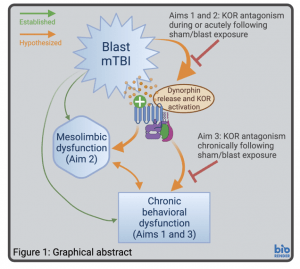Causal mechanism and therapeutic potential of the dynorphin/kappa opioid receptor system in blast-induced psychopathology

Trauma and chronic stress results in a multitude of adverse behavioral and physiological outcomes, leading to increased morbidity/mortality and impaired social and occupational functioning. Servicemembers and Veterans experience exceptionally high rates of trauma exposure, which can precipitate and/or exacerbate subsequent neuropsychiatric disorders (i.e., psychopathology). Most often repetitive in nature, blast exposure (via detonation of high explosives) represents a major source of trauma for Servicemembers, often resulting in mild traumatic brain injury (mTBI, the “signature injury” of the Iraq and Afghanistan wars) that is highly comorbid with PTSD, depression, and addiction. An estimated 400,000 Veterans have a history of blast mTBI, but prophylactic approaches, other than protective gear, do not yet exist, and treatment options have limited efficacy. Stress can result in aversion/dysphoria (a profound state of unease or dissatisfaction), mediated largely through activation of the endogenous dynorphin/kappa opioid receptor (KOR) system and subsequent maladaptive changes within the mesolimbic system. This KOR-mediated dysfunction is thought to underlie the ability of stress to precipitate and/or exacerbate psychopathology related to PTSD, depression, and addiction, but the dynorphin/KOR system has not been examined as a potential mediator of blast-induced pathology. Critically, KOR antagonists are currently under clinical trial investigation in the civilian population for treatment of stress-related psychopathology, but the potential of these drugs in a blast exposure setting has not yet been examined. Negative affect and executive dysfunction are commonly reported following blast mTBI, leading to decreased quality of life and potential risk for addictive-like behaviors, but the underlying mechanisms are not well understood. Specific Aims: 1) to determine whether KOR activation is required for blast mTBI-induced impulsivity and behavioral inflexibility (i.e., executive dysfunction). 2) to evaluate whether KOR activation is required for blast mTBI-induced mesolimbic dysfunction. 3) to establish therapeutic efficacy of KOR antagonism administered chronically following blast mTBI. These proposed studies will define, for the first time, the role of KOR activation in adverse blast mTBI outcomes and highlight this receptor system as a novel therapeutic target. Knowledge gained can be directly translated and utilized towards the development of more effective treatment approaches for Servicemembers and Veterans with a history of blast mTBI.
Creation of cell-type specific inducible knockout mice to study the role of dynorphin/kappa opioid receptor system in adverse outcomes following blast polytrauma
Given the wide expression of KOR throughout the brain on both neuronal and glial cell types, understanding how blast-induced KOR activation contributes to adverse outcomes in a cell-type specific manner is critical for mechanistic understanding and downstream therapeutic development and is the focus of a newly funded VA Puget Sound R&D Seed Grant . The VA Seed funding will allow us to generate these cell-type specific KOR knockout mice using the well-established Tamoxifen (TAM)-inducible Cre-loxP system. Mice with TAM-inducible Cre (Cre-ERT2) under the control of either a neuronal, microglia, or astrocyte specific promotor will be crossed with KOR floxed mice.